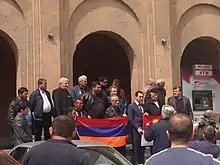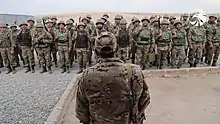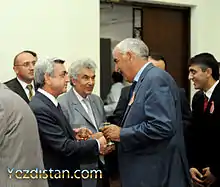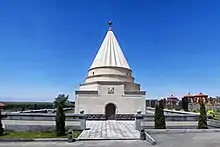Yazidis in Armenia
Yazidis in Armenia (Armenian: Եզդիները Հայաստանում,[4] Kurdish: Êzîdiyên Ermenistanê[5]) are Yazidis who live in Armenia, where they form the largest minority. Recognized as an ethnic group in Armenia,[6] majority of the Yazidis came to the country in 19th and early 20th centuries following the religious persecutions they were experiencing by the Ottoman Turks and the Sunni Kurds. According to the 2011 census around 35,000 Yazidis live in Armenia.
| Total population | |
|---|---|
| 35,272[1] (2011, census) | |
| Regions with significant populations | |
| Armavir, Aragatsotn, Ararat, Kotayk provinces and Yerevan | |
| Languages | |
| Kurmanji,[2] Armenian | |
| Religion | |
| Yazidism or Sharfadin[3] |
Election Code of Armenia guarantees one seat in the National Assembly to Yazid minority. Several religious Yazidi temples exist in Armenia, including the world's largest temple Quba Mere Diwane in Aknalich, which was opened in 2020. In 2021, the national theater of Yazidis was also opened in Vagharshapat.
History
Early 20th century
Many Yazidis came to the Russian Empire (now the territory of Armenia and Georgia) during the 19th and early 20th centuries to escape religious persecution, as they were oppressed by the Ottoman Turks and the Sunni Kurds who tried to convert them to Islam. The Yazidis were massacred alongside the Armenians during the Armenian Genocide, causing many to flee to Russian-held parts of Armenia.[7] The first ever Yazidi school was opened in Armenia in 1920.[8]
Soviet period
Yazidi intellectuals played a crucial role in fostering a secularized idea of Kurdish nationalism that would bridge across the religious divide which had historically separated Yazidi communities from their fellow Kurdish-speaking Muslims.[9] These vanguards of Soviet Kurdish culture comprised Yazidis such as the linguist Arab Shamilov, the writer Hajiye Jndi and the poet Shikoye Hasan. Based on a Latin alphabet developed for the Kurmanji vernacular of Kurdish by the Yazidi linguist Arab Shamilov the Kurdish-speaking newspaper Ria Teze was published in Yerevan from the 1930s onwards.
Nagorno-Karabakh War


The Yezidi movement erupting in Armenia in 1988 appealed to the 3rd All-Armenian Yezidi Assembly convened on 30 September 1989 (the two previous Assemblies occurred at the dawn of the Armenian SSR's history, in 1921 and 1923) to challenge the Government for the official recognition of their identity. As a result, the Yezidis were presented as a separate minority in the USSR population census of 1989. According to this very census, the total count of Yezidis in Armenia was 52,700. Also need to note that in Karabakh war participated more than 500 yezidis by ethnicity, they have a detachment "Jangir Agha" headed by Aziz Tamoyan.[8]
Many Yezidis volunteered during the First Nagorno-Karabakh War to fight on the Armenian side.[8]
In 2020, after the break out of the Second Nagorno-Karabakh war, many Yezidis in Armenia again volunteered to defend Artsakh.[10]
Present situation
Demographics
According to the 2011 census, there are 35,272 Yazidis in Armenia.[1] Ten years earlier, in the 2001 census, 40,620 Yazidis were registered in Armenia.[11] Media have estimated the number of Yazidis in Armenia as between 30,000 and 50,000. Most of them are descendants of refugees to Armenia following the persecution during Ottoman rule, including during the Armenian Genocide, when many Armenians found refuge in Yazidi villages.[12] A minority of Yazidis in Armenia (around 3,600) converted to Christianity,[13] but they are not accepted by the other Yazidis as Yazidis.[14] Yazidis in Armenia are recognized as an ethnic group, which according to a report has been perceived as an attempt to promote a non-Kurdish identity and has angered many in the community.[15] Sympathy for the Kurdistan Workers' Party is also widespread.[16][17]
Age structure
Ethnic Yazidis have a slightly younger population compared to ethnic Armenians. Almost 54 percent is under thirty years old, while 8 percent is aged sixty or more.
| Population (urban, rural) by Ethnicity, Sex and Age as of 2011 census[18] | ||||||||||||||||||
|---|---|---|---|---|---|---|---|---|---|---|---|---|---|---|---|---|---|---|
| Ethnic group | Total | 0 – 9 | 10 – 19 | 20 – 29 | 30 – 39 | 40 – 49 | 50 – 59 | 60+ | ||||||||||
| Yazidis | 35,308 | 5,984 | 6,236 | 6,795 | 5,193 | 4,645 | 3,624 | 2,831 | ||||||||||
| Share per age group (%) | 100.0 | 16.9 | 17.7 | 19.2 | 14.7 | 13.2 | 10.3 | 8.0 | ||||||||||
Political rights
Election Code of Armenia guarantees one seat in the National Assembly to Yazid minority.[19]
Culture
In January 2021, the national theater of Yazidis was opened in Vagharshapat, with the first play being about the fallen Yazidi soldiers of the 2020 Nagorno-Karabakh war.[20]
Memorials and religious sites
_(3).jpg.webp)
In 2016 a memorial for fallen Yazids is installed in Yerevan downtown in the park at the crossing of Isahakyan and Nalbandyan streets.[21][22]
As of 2016, the world's largest Yazidi temple is under construction in the small village of Aknalich.[23] The temple named Quba Mere Diwane opened on 2 September 2019, and is dedicated to Melek Taus, one of seven angels in Yazidi theology.
Foreign evaluations of Yazid rights

US reports on the relations between Yazidis and the Armenian government have been mixed. According to a 2004 U.S. Department of State human rights report, Yazidis are subjected to some harassment in Armenia. Attendance school rates among children in the Yezidi ethnic minority continued to be lower than average, partially due to economic reasons, a lack of Yezidi teachers and books, and the early removal of teenage girls from schools for marriage. In 2006 the UN Children's Fund (UNICEF) supported the government's effort to publish textbooks for ethnic minorities, and in 2007 new Yezidi language textbooks appeared in some Yezidi schools around the country. The textbooks are Aziz. and Hasan Shex Mamude. Also through Armenian government support the first Yezidi newspaper was published named Ezdikhana (ex. name: Denge Ezdia or Yezidi Voice).[24]
Armenia has been described as "the best country for their survival as a community" by the Yazidis.[2] However, according to several reports, discriminations against Yazidis exists in the country.[25][26] In an 2007 U.S. Department of State human rights report states that "as in previous years, Yezidi leaders did not complain that police and local authorities subjected their community to discrimination".[27]
Distribution
| Province (marz) | Yazidis | % of Yazidis in Armenia | |||||
| Armavir | 17,665 | ||||||
| Aragatsotn | 6,405 | ||||||
| Ararat | 5,940 | ||||||
| Yerevan | 4,733 | ||||||
| Kotayk | 4,097 | ||||||
| Shirak | 974 | ||||||
| Lori | 793 | ||||||
| Gegharkunik | 8 | ||||||
| Syunik | 4 | ||||||
| Tavush | 1 | ||||||
| Vayots Dzor | 0 | ||||||
| Total | 40,620 | 100% | |||||
|---|---|---|---|---|---|---|---|
There are 22 rural settlements in Armenia with Yazidi majority. The biggest Yazidi village in Armenia is Verin Artashat in Ararat Province with 4,270 residents.
Aragatsotn Province
There are 19 Yazidi-inhabited villages in Aragatsotn Province.
| Aragats district | Talin district | Ashtarak district |
|---|---|---|
Armavir Province


There are two Yazidi villages in Armavir Province: Yeraskhahun and Ferik, both in Ejmiatsin district.
On 29 September 2012 Yazidis opened their first temple outside their Lalish homeland - the temple of "Ziarat" in Aknalich village in Armavir province of Armenia.[28][29] In August 2015 an architectural design for a new temple in Aknalich was released; the temple is planned to be completed in 2017.[30] This temple, the world's largest Yazidi temple, was built next to the Ziarat temple and has opened in September 2019, under the name "Quba Mere Diwane".[31]
Ararat Province
The only Yazidi village is Verin Artashat, near Artashat.
Notable Armenian-Yazidi people
See also
References
- "2011 Armenian census" (PDF). National Statistical Service. 2011. Retrieved 9 December 2015.
- "Yazidi bleeding hearts: The fragility of Armenia's largest ethnic minority". The Independent. October 25, 202p. Retrieved January 29, 2021.
- Asatrian, Garnik S.; Arakelova, Victoria (2014-09-03). The Religion of the Peacock Angel: The Yezidis and Their Spirit World. Routledge. ISBN 978-1-317-54429-6.
- "Ինչ բիզնեսներ ունեն եզդիները' Հայաստանում". Arevelk (in Armenian). Retrieved 28 December 2019.
- "Hêjeya Êzîdiyan li Ermenîstanê Êzîdî ya Gurcistanê ye" (in Kurdish). Retrieved 28 December 2019.
- "The Ethnic Minorities of Armenia" (PDF). Yerevan. 2002.
- Ian S. McIntosh. "A Conditional Coexistence:Yezidi in Armenia". Archived from the original on 2007-12-23.
- "THE ETHNIC MINORITIES OF ARMENIA" (PDF). Archived from the original (PDF) on 2007-07-10.
This publications has been made possible due to the support by the Government of the United Kingdom of Great Britain and Northern Ireland, with the assistance of the OSCE Office in Yerevan
- Leupold, David (2019-11-21). ""Fatally Tied Together": The Intertwined History of Kurds and Armenians in the 20th Century". Iran and the Caucasus. 23 (4): 390–406. doi:10.1163/1573384X-20190409. ISSN 1573-384X.
- "Եզդիական համայնքի բազմաթիվ ներկայացուցիչներ կամավորագրվել են Արցախ մեկնելու համար". Armenpress. September 28, 2020. Retrieved December 19, 2020.
- "De Jure Population (Urban, Rural) by Age and Ethnicity" (PDF). National Statistical Service. 2001. Retrieved 9 December 2015.
- Torikian, Aren (27 August 2014). "Confronting the Yazidi Genocide". The Armenian Weekly.
- "Population (urban, rural) by Ethnicity, Sex and Religious Belief" (PDF). Statistics of Armenia. Statistics of Armenia. Retrieved 22 May 2019.
- Aghayeva, Elene Shengelia, Rana (2018-09-06). "Georgia's Yazidis: Religion as Identity - Religious Beliefs". chai-khana.org. Retrieved 2019-08-30.
- "Armenia: Yezidi Identity Battle". Global Voices: Caucasus. 3 November 2006. Retrieved 24 January 2021.
- Krikorian, Omnik (2008). "Yezidi Minority in Armenia Unsure of Its Identity by Omnik Krikorian". Genocide Prevention Now. 5.
- Godfrey (9 December 2015). "Garnik Asatrian and Onnik Krikorian on Armenian-Kurdish ties; WikiLeaks-2006". ANI Armenian Research Center (ANIARC).
- "Population (urban, rural) by Ethnicity, Sex and Age" (PDF). www.armstat.am.
- "DocumentView". www.arlis.am. Retrieved 2018-01-25.
- "Եզդիների ազգային թատրոնը կգործի Հայաստանի հոգևոր մայրաքաղաքում՝ Էջմիածնում". Public Television Company of Armenia. January 18, 2021. Retrieved January 19, 2021.
- hy:Եզդի ժողովրդի անմեղ զոհերի հուշարձան-կոթող (Երևան)
- "Genocide Museum | The Armenian Genocide Museum-institute". www.genocide-museum.am. Retrieved 2018-01-25.
- Sherwood, Harriet (25 July 2016). "World's largest Yazidi temple under construction in Armenia". The Guardian. Retrieved 31 July 2016.
- "Country Report on Human Rights Practices in Armenia". State.gov. 2005-02-28. Retrieved 2015-09-19.
- "Alternative report on Armenia's implementation of the International Convention on the Elimination of All Forms of Racial Discrimination" (PDF). Office of the United Nations High Commissioner for Human Rights. 2017. p. 8.
- "Armenia 2019 International Religious Freedom Report" (PDF). United States Department of State. 2009. p. 7. Retrieved 23 January 2021.
According to the December Alternative Report to the UN Committee on the Rights of the Child with a Focus on Yezidi Children in Armenia prepared by local NGOs, minority children were frequently deprived of their freedom to practice their religion and faced a number of challenges in preserving and expressing their ethnic and religious identities...
- "Country Report on Human Rights Practices in Armenia". State.gov. 2008-03-11. Retrieved 2015-09-19.
- Archived April 22, 2014, at the Wayback Machine
- "Ziarat Day". ArmeniaNow.com. 2012-09-29. Retrieved 2015-09-19.
- "New Temple In Armenia: Laying Of Foundation Stone To Start In September – EzidiPress English". Ezidipress.com. Retrieved 2015-09-19.
- Omar, Shahla (2019-09-30). "World's largest Yezidi temple opens in Armenia". Rudaw.net. Retrieved 2019-10-01.
- Zidan, Karim (30 April 2016). "MMA Hitman: The former UFC fighter who became a dangerous contract killer". Bloody Elbow. Retrieved 30 April 2016.
- Joanna Bocheńska (2018). Rediscovering Kurdistan's Cultures and Identities: The Call of the Cricket. p. 95.
- "Քյարամ Սլոյան Քյալաշի". Anunner.com. Retrieved 2016-04-21.
| Wikimedia Commons has media related to Yazidis in Armenia. |
